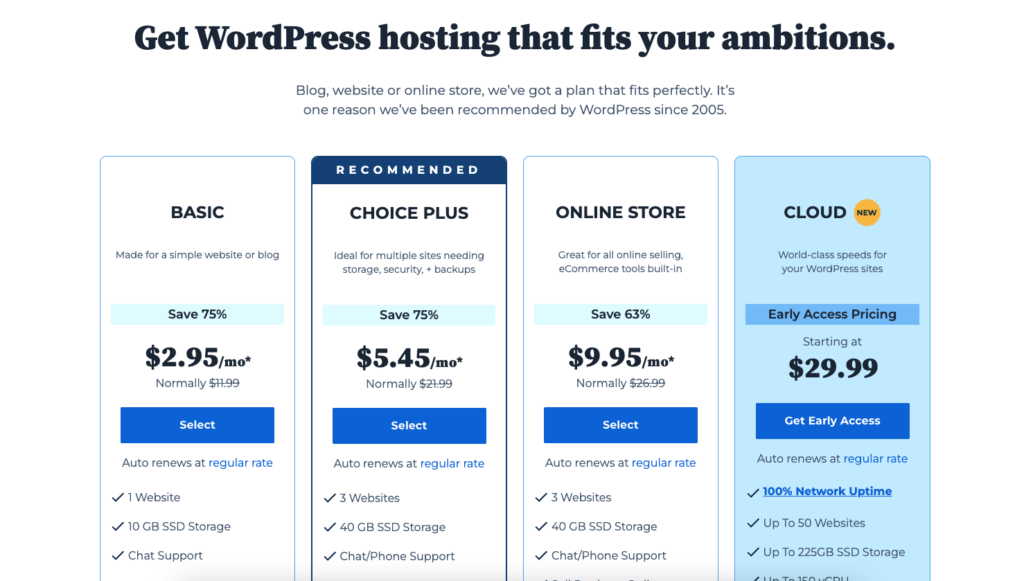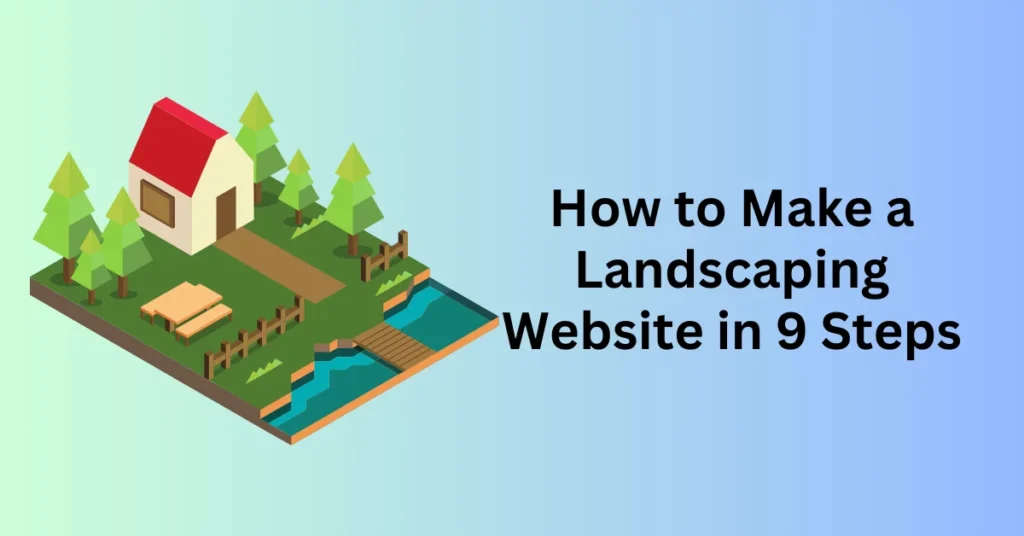If you’re looking to start or grow your landscaping business and don’t have a website yet, making it a priority should be at the top of your to-do list. In today’s digital world, potential clients turn to the internet to search for local services, compare options, and make informed choices. A professionally designed website boosts your online presence and provides a clear, compelling view of what you offer.
Think of your website as an essential business asset that works 24/7. It not only draws in new clients by showcasing your portfolio but also helps generate leads with easy-to-use contact forms. Additionally, it can build trust and credibility through customer testimonials and reviews.
This guide will walk you through each step of creating a standout website that not only captures your brand identity but also sets you apart from the competition. By the end, you’ll have a site that works seamlessly to attract and engage customers while highlighting your landscaping expertise.
Why Your Landscaping Business Needs a Website

In today’s digital age, having a website is no longer a luxury for businesses—it’s a necessity. If you’re wondering whether your landscaping service really needs an online presence, think about how people search for services. Most potential clients start their journey online, comparing local businesses and evaluating their options based on the information they find. Without a professional website, you risk being overlooked in favour of competitors who appear more credible and accessible.
Your 24/7 Digital Storefront
A website serves as your business’s digital storefront, open 24/7 to potential clients. It’s more than just an online presence; it’s a platform where you can showcase your expertise, highlight your unique style, and provide essential information. Through a well-designed website, you can display high-resolution images of your most impressive projects, describe your range of services in detail, and make it easy for clients to get in touch with you. Additionally, a website is an opportunity to communicate your business values, build trust, and even integrate convenient features like online booking or instant quotes.
Expand Your Reach
A website significantly broadens your potential audience beyond traditional word-of-mouth referrals and offline advertising. By appearing in search engine results, you can connect with homeowners and businesses actively searching for landscaping services in your area. Even when clients hear about your business through a personal recommendation, they are likely to visit your website to learn more about your offerings before reaching out. A strong online presence ensures you don’t miss out on these opportunities.
Showcase Your Expertise
Landscaping is a visual art, and your website gives you the perfect platform to display your best work. High-quality images of beautifully designed gardens, patios, and hardscaping projects can speak volumes about your skills and creativity. A visually appealing portfolio not only sets you apart from competitors but also helps potential clients envision how you can transform their outdoor spaces. Consider adding before-and-after photos to further illustrate your expertise.
Streamline Client Interactions
One of the most significant advantages of having a website is the convenience it offers to potential customers. By incorporating features such as contact forms, online booking tools, and quote request options, you can make it incredibly easy for clients to take the next step. In addition, simplifying the process of scheduling appointments or requesting estimates helps to reduce barriers for potential customers. As a result, this not only enhances the user experience but also increases the likelihood of converting website visitors into paying clients.
Establish Trust and Credibility
A professional website is a powerful tool for building trust with potential clients. In today’s market, a polished online presence signals reliability and professionalism. Clients are far more likely to choose a landscaping business with a well-designed website over one that lacks any online presence. Including elements such as customer testimonials, industry certifications, and detailed case studies can further solidify your reputation and reassure clients of your expertise.
Work for You Around the Clock
Think of your website as an employee who never clocks out. It provides potential clients with a welcoming and informative space to learn about your services whenever it’s convenient for them. Whether they’re browsing during a lunch break or late at night, your website is always available to showcase your work, answer their questions, and guide them toward contacting you. By generating leads and building your brand around the clock, a website is an invaluable asset for growing your landscaping business.
In an industry as competitive as landscaping, a website is no longer optional—it’s essential. From showcasing your work to expanding your reach and building credibility, a well-designed website is a cornerstone of modern business success. By investing in a professional online presence, you’ll not only stand out in your local market but also create a reliable platform for connecting with new clients and growing your business.
Steps to build a landscaping company website
Building a landscaping website might seem overwhelming at first, but breaking it down into manageable steps can make the process much easier. By following these ten steps, you can create a professional, visually appealing, and functional website that not only attracts potential clients but also helps grow your landscaping business.
Step 1: Plan Your Landscaping Website
Every great website starts with a well-thought-out plan. Before you dive into the design process, take time to map out your website’s structure, objectives, and content. Determine what information you want to share and how visitors will navigate through your site. A solid plan ensures your website is both user-friendly and visually engaging.
For landscaping businesses, your website should include a few key pages at a minimum. Here’s a breakdown of the essentials:
Home Page
As the first page most visitors will see, your homepage should make an excellent first impression. Use high-quality images of your best landscaping projects to immediately capture attention. Pair this with concise, engaging text that introduces your business and communicates your value. Highlight your most in-demand services and include a compelling call-to-action (CTA), such as “Get a Free Estimate Today” or “Transform Your Yard—Contact Us Now.” This not only encourages visitors to take action but also helps boost your website’s performance on search engines.
Services Page
Your services page is where you can really showcase what sets your business apart. Go beyond simply listing services—explain each one in detail, emphasizing unique aspects like “customized garden designs” or “eco-friendly landscaping practices.” Be specific about what clients can expect and highlight the benefits of working with your company. Including before-and-after photos or examples of completed projects can help potential clients visualize what you can do for them.
About Page
Customers want to do business with people they trust, and your About page is your chance to build that trust. Share your company’s story—how you got started, your mission, and the values that drive your work. Introduce your team, including their qualifications and expertise, to add a personal touch. Including professional photos of your team can help humanize your business and make it easier for clients to connect with you.
Contact Page
A well-designed Contact page ensures that potential customers can easily get in touch with you. Provide multiple methods of contact, such as a phone number, email address, and a simple contact form. Don’t forget to include your service area and, if applicable, a map showing your office location. This is especially important for landscaping businesses that cater to local clients. The easier it is for someone to contact you, the more likely they’ll take the next step.
Optional Pages for Your Landscaping Website
While the pages above are essential, adding a few optional pages can set your website apart and further engage visitors:
- Gallery Page: Create a visual portfolio of your best landscaping projects. High-quality images of completed work can inspire potential clients and demonstrate the quality of your services.
- Blog Page: Share valuable content, such as landscaping tips, seasonal yard maintenance advice, or trends in outdoor design. A blog not only positions you as an expert in your field but also helps improve your website’s search engine rankings.
By carefully planning and building these pages, you’ll create a website that showcases your landscaping business in the best light and converts visitors into clients.
Step 2: Select the Best Platform for Your Landscaping Website
Choosing the right platform is a critical step in building a landscaping website that is both functional and visually appealing. For most landscaping businesses, WordPress paired with Bluehost is an excellent choice due to its simplicity, flexibility, and scalability. This combination empowers you to create a professional website without requiring advanced technical skills or a large budget.
Why WordPress Stands Out
- Ease of Use
WordPress is incredibly beginner-friendly. You don’t need any coding knowledge to design and manage a professional website. With its intuitive interface and drag-and-drop editing tools, even first-time users can confidently build and update their site. - Flexibility
WordPress offers unmatched customization options. With thousands of themes and plugins at your fingertips, you can tailor your website to meet the unique needs of your landscaping business. Whether you want to display a portfolio, integrate contact forms, or optimize for local SEO, WordPress has the tools to make it happen. - Scalability
As your business grows, so can your website. WordPress allows you to add new features and functionality over time, ensuring your site evolves alongside your landscaping company.
Why WordPress and Bluehost Are Ideal for Landscaping Websites
When building a landscaping website, pairing WordPress with Bluehost creates the perfect foundation for success. This powerful combination offers affordability, ease of use, and tools specifically designed for small businesses in the local service industry. Here’s why it’s a smart choice for landscapers:
- Simplicity and User-Friendly Setup
Bluehost makes launching your WordPress website straightforward, even if you have zero technical experience. Their platform guides you through the entire process, from registering your domain name to installing WordPress with just one click. You can have your website live in minutes without worrying about complicated setups or configurations. - Cost-Effective Solution for Small Businesses
For landscaping companies operating on a budget, Bluehost delivers exceptional value. Their hosting plans bundle essential services like domain registration, SSL certificates (for website security), and reliable hosting into one affordable package. This all-in-one approach saves both time and money, giving your website everything it needs to succeed. - Optimized for Local Service Businesses
As a landscaper, your main goal is to attract clients within your local area. Bluehost provides tools to enhance your website’s visibility in local search results, helping nearby homeowners and businesses find your services. Coupled with WordPress, you can take advantage of themes and plugins designed to highlight your services, showcase your service areas, and simplify communication with potential clients.
Streamline Website Building with Elementor
For beginners, Elementor makes building your WordPress site even easier. This powerful page builder plugin allows you to create a stunning website using drag-and-drop functionality. Here’s how Elementor simplifies the process:
- Step-by-Step Guidance: Elementor walks you through every stage of website creation, from selecting a theme to customizing your site’s layout.
- Professional Design Made Easy: You can easily adjust colours, fonts, and images to reflect your brand without hiring a designer.
- Essential Page Customization: Quickly add pages like a portfolio, contact forms, and service descriptions using pre-built templates, saving you time while ensuring your site looks polished and professional.
By using WordPress, Bluehost, and Elementor together, you’ll have all the tools you need to create a landscaping website that not only looks amazing but also attracts and converts local clients effectively.
Step 3: Set Up Hosting and Secure a Domain Name
Before you can start building your landscaping company’s website, you need two essential components: a domain name and web hosting. These form the foundation of your website, ensuring it is accessible to visitors and easy to find online.
Choosing the Perfect Domain Name
Your domain name is your website’s digital address—essentially the first thing potential clients notice about your online presence. To make a strong impression, follow these tips when selecting a domain name:
- Make It Memorable: Choose a name that reflects your landscaping business and is easy to remember. For example, names like GreenLandscaping.com or PerfectLawnPros.com are clear and professional.
- Keep It Simple: Avoid overly long or complicated names. Choose something short and easy to spell to ensure clients can easily type it into their browser.
- Be Relevant: Incorporate words related to your services or location. For example, if the name you want is unavailable, try adding your city or service type, such as GreenOasisLandscapingNY.com or EliteGardenDesigns.com.
- Secure Your Brand: Register additional extensions (.net, .biz) or variations of your domain name to protect your brand identity.
Selecting the Right Hosting Plan
Web hosting is what makes your website accessible on the internet, storing its files and ensuring it loads quickly for visitors. When evaluating hosting providers, prioritize the following features:
- Reliability: Look for a hosting provider with a high uptime guarantee (at least 99.9%) to ensure your website is always accessible.
- Speed: A fast website enhances the user experience and improves your search engine rankings. Choose hosting providers optimized for speed.
- Scalability: As your business grows and website traffic increases, you’ll need hosting that can grow with you. Opt for providers that offer easy upgrades.
- Security: Protect your website and clients’ data with hosting plans that include SSL certificates (to enable secure HTTPS browsing) and malware protection.
Many hosting providers, like Bluehost, offer bundled packages that include hosting, domain registration, and additional tools like email hosting. This all-in-one approach simplifies the setup process and ensures your website has everything it needs.

Once you’ve secured a domain name and hosting plan, the next step is to connect the two. This process typically involves:
- Pointing Your Domain to Your Hosting Provider: This is done by updating your domain’s DNS settings to match your hosting provider’s servers.
- Following Provider Instructions: Most hosting providers, like Bluehost, include detailed, step-by-step instructions in their dashboard to guide you through this process.
Once connected, your website is officially live and ready for the next phase—installing a content management system (CMS) to begin building your site.
Why Using Bluehost?
Setting up hosting and a domain can feel daunting, especially for beginners. That’s where Bluehost shines, offering an all-in-one solution that makes it easy to get started.

- Convenient All-in-One Setup
Bluehost streamlines the process by bundling domain registration, web hosting, and essential tools into a single package. You won’t have to worry about managing multiple providers or connecting services manually. - Beginner-Friendly Interface
With an intuitive dashboard designed for users of all skill levels, Bluehost simplifies every step. From selecting a domain name to choosing a hosting plan, the process is straightforward and hassle-free. - Fast and Secure Hosting
Bluehost ensures your website runs smoothly with reliable hosting, fast load times, and robust security features like free SSL certificates and malware protection. This builds trust with visitors and improves your search engine rankings. - 24/7 Customer Support
Whether you need help choosing a domain, connecting your hosting, or troubleshooting a technical issue, Bluehost’s dedicated support team is available around the clock via chat, email, or phone. - Extra Tools for a Professional Start
Bluehost includes additional tools to make website setup even easier:- Domain Search: Quickly find and register a domain name that matches your landscaping business.
- One-Click WordPress Installation: Skip the hassle and install WordPress with a single click, so you can immediately start designing your site.
Step 4: Customize Your Landscaping Website Design
Customizing your website is where your vision starts to take shape. This step is all about creating a unique, visually appealing, and user-friendly site that not only reflects your landscaping brand but also makes a lasting impression on visitors. A polished, professional design builds trust and encourages potential clients to reach out for your services.
Choose a Landscaping-Specific WordPress Theme
The foundation of your website’s design is its theme. WordPress offers thousands of themes, including ones tailored specifically for landscaping and other service-based businesses. Choosing the right theme ensures your site is both visually stunning and functional. Here’s what to look for in a landscaping-specific theme:
- Visual Appeal: Opt for a theme that allows you to showcase your work through image galleries, sliders, or videos. High-quality visuals are a must in the landscaping industry to help potential clients envision your capabilities.
- Customizable Features: Look for themes that make it easy to adjust colors, fonts, and layouts to align with your branding. This flexibility lets you create a site that feels uniquely yours.
- Service-Focused Tools: Choose a theme with built-in features like contact forms, service area maps, and portfolio sections. These elements save time and are specifically designed to meet the needs of local service businesses.
A landscaping-specific theme provides a strong starting point with pre-designed layouts and tools tailored to your industry, saving you time while ensuring your website looks professional.
Add Your Branding
Your website should reinforce your business identity by incorporating your branding throughout its design. Consistent branding builds recognition and sets you apart from competitors.
- Logo: Place your logo prominently on your site, such as in the header, footer, and homepage. It should be visible on every page to strengthen brand recognition.
- Colours: Use a colour palette that reflects your landscaping brand. Greens and earthy tones work well for landscaping companies, as they evoke nature and professionalism.
- Fonts: Choose clean, legible fonts for both headings and body text. Consistency in typography makes your site look polished and easy to read.
Integrating these elements ensures your website feels cohesive and professional, leaving a positive impression on visitors.
Design a User-Friendly Layout
A well-designed website isn’t just about aesthetics—it must also be functional and easy to navigate. A user-friendly layout ensures visitors can quickly find the information they’re looking for, which can increase conversions.
- Highlight Key Services: Use your homepage to guide visitors to your most popular services or current promotions.
- Add Call-to-Action (CTA) Buttons: Include clear, prominent CTAs like “Request a Quote” or “Schedule a Free Consultation” to encourage engagement.
- Ensure Mobile Responsiveness: With many clients browsing on smartphones or tablets, it’s essential that your site looks great and functions smoothly on all devices.
Showcase Your Work Visually
As a landscaping business, your portfolio is one of your strongest marketing tools. Use your website to display your completed projects with high-quality visuals.
- Add a photo gallery categorized by project type (e.g., patios, gardens, or hardscaping).
- Include before-and-after comparisons to illustrate the impact of your work.
- Consider embedding videos to provide a dynamic view of your projects.
Visual elements not only make your site more engaging but also help potential clients envision what you can achieve for them.
Once you’ve customized your website, it’s time to test its functionality and appearance. Go through each page to ensure everything loads correctly, aligns visually, and offers a seamless user experience. Ask colleagues, friends, or trusted clients for feedback and make any necessary adjustments.
Step 5: Add Essential Plugins for Landscaping Businesses
Plugins are indispensable tools for enhancing your landscaping website’s functionality. They allow you to showcase your services, optimize your site for visibility, streamline client communication, and improve the overall user experience. Here are the must-have plugins to consider for your landscaping business website:
1. Service Area Plugin
A service area plugin helps clearly define where your landscaping business operates, ensuring potential clients know exactly where to find your services. These plugins often come with interactive maps, location lists, and customizable branding options to help you display your coverage area in a professional manner. This is essential for reducing inquiries from areas outside your service range, saving both you and potential clients time. Popular plugins for this purpose include WP Google Maps and SimpleMap.
2. SEO Tools
Search Engine Optimization (SEO) is crucial for improving your website’s visibility, especially in local search results. SEO tools offer a range of features such as keyword optimization, meta descriptions, performance suggestions, and XML sitemaps to help your website rank higher in search engines. These tools make it easier for local customers to find your landscaping services, which directly leads to more traffic and potential leads. Well-known SEO plugins for WordPress include Yoast SEO, Rank Math, and SEOPress.
3. Contact Form Plugins
Contact form plugins are essential for providing an easy way for potential clients to reach out to you. These plugins allow you to add customizable forms that can handle inquiries, quote requests, appointment scheduling, and even CRM integration. Streamlining communication through a contact form makes it easier to manage leads and stay in touch with interested clients. Popular contact form plugins include WPForms, Contact Form 7, and Ninja Forms.
4. Portfolio or Gallery Plugins
Since landscaping is a visually driven business, having a portfolio or gallery plugin is key to showcasing your work effectively. These plugins allow you to display images in an organized and visually appealing way, often with features like image sliders, lightboxes, before-and-after galleries, and category filters. A well-curated portfolio not only highlights the quality of your work but also demonstrates the variety of services you offer, helping build trust with potential clients. Popular options include NextGEN Gallery, Envira Gallery, and Modula.
5. Performance Optimization Plugins
Website speed is essential for both user experience and SEO. Performance optimization plugins help enhance the loading times of your website by compressing images, caching pages, and optimizing code. A faster website improves user engagement and keeps visitors from bouncing, which in turn boosts your search engine rankings. Plugins like WP Rocket, W3 Total Cache, and Smush are commonly used to optimize performance and improve your website’s overall speed.
6. Security Plugins
Securing your website should be a top priority to protect it from potential hackers, malware, and other online threats. To achieve this, security plugins are invaluable, as they typically include features such as firewall protection, malware scanning, and enhanced login security. By implementing these tools, you can effectively safeguard both your website and your client data. Furthermore, having a secure website is crucial for building trust with clients, as it ensures their personal information is protected. Popular security plugins like Wordfence Security, Sucuri, and iThemes Security can provide the robust protection you need.
7. Appointment or Booking Plugins
Appointment or booking plugins allow clients to schedule consultations or appointments directly from your website, automating the process for both you and your clients. These plugins often feature real-time booking calendars, client notifications, and payment integration, making the scheduling process seamless and efficient. By automating bookings, you save time and reduce the chances of scheduling conflicts or miscommunication. Popular booking plugins include Amelia, Simply Schedule Appointments, and Bookly.
How Plugins Enhance Your Landscaping Business
Adding the right plugins can significantly enhance your website, transforming it into a powerful tool for growing your business. These plugins help streamline various aspects of your operations, starting with communication. By integrating contact forms and booking tools, you simplify the process for clients to reach out or schedule appointments directly through your site, improving both convenience and client engagement.
Another key benefit is the ability to showcase your expertise. Through galleries and portfolios, you can visually display the quality and variety of your work, helping potential clients understand your capabilities and build trust in your services. This visual representation of your skills can be crucial in attracting new business.
Plugins also play a crucial role in boosting your website’s visibility. With SEO optimization tools, you can enhance your site’s search engine ranking, making it easier for local clients to find your services online. This increased visibility can lead to more traffic and potential clients discovering your business.
Lastly, plugins can help streamline operations by automating processes such as scheduling, improving website performance, and ensuring the security of your data. With these tools in place, your website becomes more efficient, freeing up time and resources while also providing a seamless experience for both you and your clients.
Step 6: Create Content for Your Website
Content is the heart of your landscaping website—it’s what turns a simple online presence into a dynamic tool for attracting clients and growing your business. Clear, engaging, and informative text tailored to your audience is essential. Here’s how to craft compelling content for each key section of your site:
Home Page
Your home page is often the first impression potential clients have of your landscaping business, so it’s essential to make it stand out. Start by clearly introducing your business and what you do, such as: “At Green Oasis Landscaping, we transform outdoor spaces into beautiful, functional areas you’ll love.” This statement helps visitors understand your services right away.
Then, highlight the value you offer by showing how your services solve common client problems—whether it’s enhancing curb appeal or creating a relaxing backyard retreat. Finally, guide visitors with a clear call to action (CTA) like “Request a Free Quote” or “View Our Portfolio,” encouraging them to take the next step and explore your services further.
Service Descriptions
Providing detailed and engaging descriptions of your services is key to helping clients understand the value you bring. Start by listing your core services such as landscaping design, maintenance, hardscaping, and irrigation. Then, focus on the benefits your services provide—like boosting property value, saving time with regular maintenance, or helping clients achieve their dream outdoor space.
Use client-centric language that speaks directly to your audience, for example, “We’ll work with you to create a custom design that suits your style and needs.” This approach builds trust and shows you care about delivering tailored solutions.
About Us Page
The “About Us” page plays a critical role in building trust with your audience. It’s an opportunity to share the story behind your landscaping business and your values. Introduce your team by highlighting your collective experience and credentials, showcasing your expertise.
Share your mission to help visitors connect with your passion for landscaping and your commitment to client satisfaction. Adding a personal touch, such as a friendly team photo or a fun fact about your business, helps make your brand more relatable and approachable.
Testimonials and Case Studies
Showcasing testimonials and case studies on your website can significantly increase credibility and trust. Include quotes from happy clients that highlight the reliability, quality, and professionalism of your services. These testimonials act as social proof, giving potential clients confidence in your ability to deliver great results.
In addition to testimonials, share detailed case studies of successful projects, including the challenges you faced, the solutions you provided, and the results you achieved. Accompany these stories with before-and-after photos to visually demonstrate the impact of your work.
Blog (Optional)
Having a blog on your website is a fantastic way to position yourself as an industry expert while providing valuable content to your visitors. You can write about landscaping tips, seasonal advice, and the latest trends in the industry. Some potential blog topics include: “5 Landscaping Ideas to Boost Your Home’s Curb Appeal,” “Seasonal Lawn Care Tips for [City Name] Homeowners,” or “How to Choose the Right Plants for Your Backyard.”
By regularly sharing helpful and informative posts, you engage your audience and build authority in your field.
Use Calls to Action (CTAs)
Strategically placing calls to action (CTAs) throughout your website is crucial for guiding visitors toward the next step. Whether it’s encouraging them to get in touch, schedule a consultation, or view your latest projects, CTAs direct users to take action. Examples include: “Get a Free Quote,” “Schedule a Consultation,” or “View Our Latest Projects.”
These clear, action-oriented statements prompt visitors to engage with your services and move closer to becoming clients.
Step 7: Optimize for Local SEO
Local SEO ensures your landscaping website is easily discoverable by potential clients in your area. Follow these steps to improve your local search rankings:
Use Location-Specific Keywords
Incorporate your city, region, or neighborhood into your website content, including:
- Page Titles and Headlines: Example: “Professional Landscaping Services in [City Name]”
- Service Descriptions: Mention areas you serve, like “We proudly provide landscaping services to homeowners in [City], [Region].”
- Meta Descriptions: Add location details to entice searchers to click on your site.
Claim Your Google Business Profile
Claiming and optimizing your Google Business Profile boosts your visibility in local search results.
- Include Accurate Information: Add your business name, address, phone number, and website.
- Add Photos: Upload high-quality images of your completed projects.
- Encourage Reviews: Ask satisfied clients to leave positive reviews, as they greatly impact your local rankings.
By creating engaging content and optimizing for local SEO, you’ll position your landscaping website as a go-to resource for clients in your area. This combination of compelling copy and strategic visibility ensures that your site attracts, engages, and converts visitors into loyal customers.
Step 8: Implement Marketing Tools
Your website should serve as an integral part of your overall marketing strategy. Make sure it’s connected with the following tools to enhance your business’s visibility and engagement:
- PPC Campaigns: Use pay-per-click advertising to attract individuals actively searching for landscaping services. With well-targeted ads, you can increase your website’s visibility and drive more relevant traffic.
- Email Marketing: Stay in touch with your customers by sending out newsletters, promotions, and updates. Consistent email communication keeps your brand top of mind and helps nurture relationships with potential and existing clients.
Step 9: Test and Launch Your Website
Before going live, thoroughly test your website to ensure everything is working as it should. Pay attention to these essential areas:
- Page Links: Test every link to make sure none are broken and that all content is correctly displayed. A seamless user experience is critical to keeping visitors on your site.
- Mobile Responsiveness: Ensure that your website is optimized for mobile devices. With many people browsing on smartphones and tablets, your site should look and perform flawlessly on all screen sizes.
- Speed Optimization: Check the loading speed of your site. Slow websites lead to high bounce rates, so optimize images, scripts, and other elements to ensure fast loading times.
Once these tests are complete and your website is polished, it’s time to go live. Begin promoting your site through local directories, social media, and targeted online ads to increase its reach and visibility.
By following these steps, you’ll create a professional landscaping website that not only attracts new clients but also fosters trust and long-term growth for your business.
Final Thoughts: How to Make a Landscaping Website in 9 Steps
Building a landscaping company website is more accessible than you might think, especially with the combination of Bluehost and WordPress. In fact, these platforms provide all the tools you need to create a professional website that effectively showcases your services and expertise. To begin with, Bluehost simplifies the process right from the start by offering easy domain registration, hassle-free hosting setup, and a one-click WordPress installation. As a result, this streamlined approach allows you to focus on building your website rather than getting bogged down in technical details.
Once your site is set up, WordPress and its intuitive tools, such as Elementor, make it easy to design a site that reflects your brand’s professionalism. Furthermore, you don’t need to be a tech expert to create a visually appealing and functional website. Whether you’re just starting out or have experience with website design, these platforms eliminate the complexities of web development. Ultimately, they offer user-friendly solutions that allow you to customize your site according to your business needs. With Bluehost and WordPress, you can confidently build a website that works for your landscaping business, driving growth and attracting potential customers.


